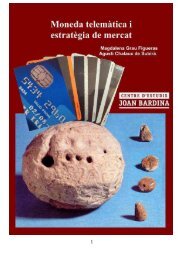Telematic currency and market strategy (mtemuk.pdf). - Centre d ...
Telematic currency and market strategy (mtemuk.pdf). - Centre d ...
Telematic currency and market strategy (mtemuk.pdf). - Centre d ...
You also want an ePaper? Increase the reach of your titles
YUMPU automatically turns print PDFs into web optimized ePapers that Google loves.
B Towards a rational monetary system.<br />
Chapter 5. Premises for a rational monetary instrument.<br />
1. This chapter's goals.<br />
2. Documentary metric systems.<br />
3. Measuring units.<br />
4. The measuring proceedings.<br />
5. The measuring documents.<br />
6. Conclusions.<br />
1. This chapter's goals.<br />
In this chapter we will take an approach to the smallest indispensable bases to have a rational system, starting<br />
from the idea that it is a metric system.<br />
The principles will be later applied to the set-up of a new monetary instrument, in a position to clear the<br />
monetary relations <strong>and</strong> to give new strength to the <strong>market</strong>.<br />
2. Documentary metric systems.<br />
As we have already seen in the previous chapter, the defining character of money systems is that of building<br />
up an abstract measuring system to measure the exchange value of the goods in a given <strong>market</strong>.<br />
Therefore, we could talk about a rational money system as long as we have an authentic metric system, that is<br />
a system which gives faithful images, isolated from reality.<br />
The minimal necessary elements for an effective metric system are the following three:<br />
1. A measuring unit rigorously defined, of a radically conventional-abstract nature.<br />
2. A measuring process to allow in practice the act of measuring: that is to allot a given <strong>and</strong> exact<br />
number of money units to every elemental real phenomenon.<br />
3. A measuring document to record every elemental measuring act, in order that every qualified person<br />
can repeat this operation, control its correctness <strong>and</strong> at the same time to allow an analytical-statistical<br />
treatment at a later date of the total measurements effected.<br />
In the case of the money system, it is necessary to have together the three mentioned elements. We will now<br />
examine them one at a time, with respect to money systems.<br />
3. Measuring units.<br />
The measuring units invented to measure the dimensions of any phenomenon, are completely abstract ideas<br />
<strong>and</strong> their creation is absolutely arbitrary. The only condition to be fulfilled is that the definition of units must<br />
be very exact <strong>and</strong> rigorous.<br />
The length unit, for example, is the meter. At the beginning it was defined as «the distance of the ten<br />
millionth part of the quadrant of the earth meridian». But at present, as we advance towards a greater<br />
accuracy <strong>and</strong> abstraction of units, there is a preference to define a meter as «the length of the journey made in<br />
empty space by flat electro-magnetic waves in 1/299,792,458 seconds».<br />
In the <strong>market</strong> science, the dimension or value which must mainly be measured is the exchange value of real<br />
goods. The unit for measuring this value is the money unit, which, because every State produces its own, has<br />
different names in different states. Let us remember that, in ancient times, every country used to define also<br />
its own units of length, weight, volume... However, money units are very special measuring units, because<br />
32



